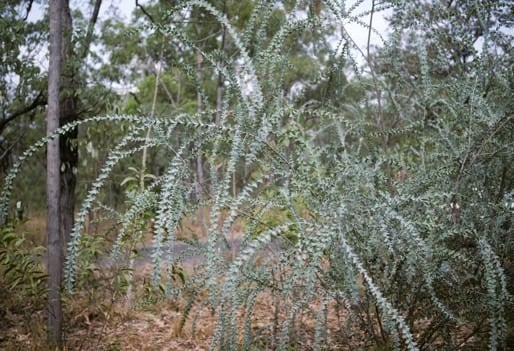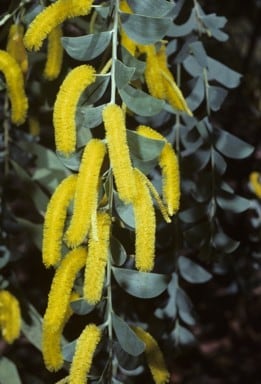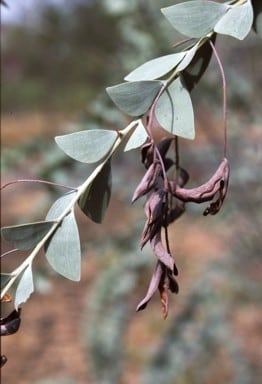Acacia mountfordiae Specht
WATTLE
Acacias of Australia
Family
Fabaceae
Distribution
Restricted to the vicinity of Oenpelli Mission, N.T.
Description
Shrub or tree to 4 m high, multistemmed, pruinose. Bark fibrous, dark grey. Branchlets terete except near apices, light brown, glabrous. Phyllodes semilunate, flat, straight or slightly curved, 1.5–4 (–5.5) cm long, (6–) 15–22 mm wide, coriaceous, glabrous, with 2–5 ±indistinct main nerves; minor nerves 6–8 per mm, fine, strongly anastomosing; gland 1, basal, to 1 mm above pulvinus. Spikes 3–4.5 cm long, golden. Flowers 5-merous; sepals free, 0.5–0.7 mm long, pubescent in lower half; corolla 1–1.2 mm long, dissected to 1/2, glabrous; ovary glabrous. Pods narrowly oblong, curved, 3.5–4.5 cm long, thickly coriaceous, glabrous. Seeds oblique, 3 mm long, black; pleurogram with halo present; areole open, pale; aril terminal.
Phenology
Flowers late June–late Sept.
Habitat
It is relatively common at the base of or on top of sandstone escarpments.
Specimens
N.T.: East Alligator R., N.Byrnes 913 (DNA, NSW, PERTH); WSW of Nabarlek, C.R.Dunlop 4973 (BRI, DNA, MEL, NSW, PERTH); 8 km SW of Oenpelli, J.R.Maconochie 1602 (DNA, NSW, PERTH).
Notes
Acacia mountfordiae is a member of the ‘A. tumida group’ but readily distinguished by its phyllode shape and size. It produces natural hybrids with another member of this group, A. difficilis, fide B.R.Maslin & M.W.McDonald (1996), A key to useful Australian acacias for the seasonally dry tropics 34 (CSIRO: Melbourne.).
FOA Reference
Data derived from Flora of Australia Volumes 11A (2001), 11B (2001) and 12 (1998), products of ABRS, ©Commonwealth of Australia
Author
Dr M.D.Tindale and Dr P.G.Kodela with the assistance of M.Bedward, S.J.Davies, C.Herscovitch, D.A.Keith and/or D.A.Morrison
Minor edits by B.R.Maslin & J.Rogers
This identification key and fact sheets are available as a mobile application:
URL: https://apps.lucidcentral.org/wattle/
© Copyright 2018. All rights reserved.














